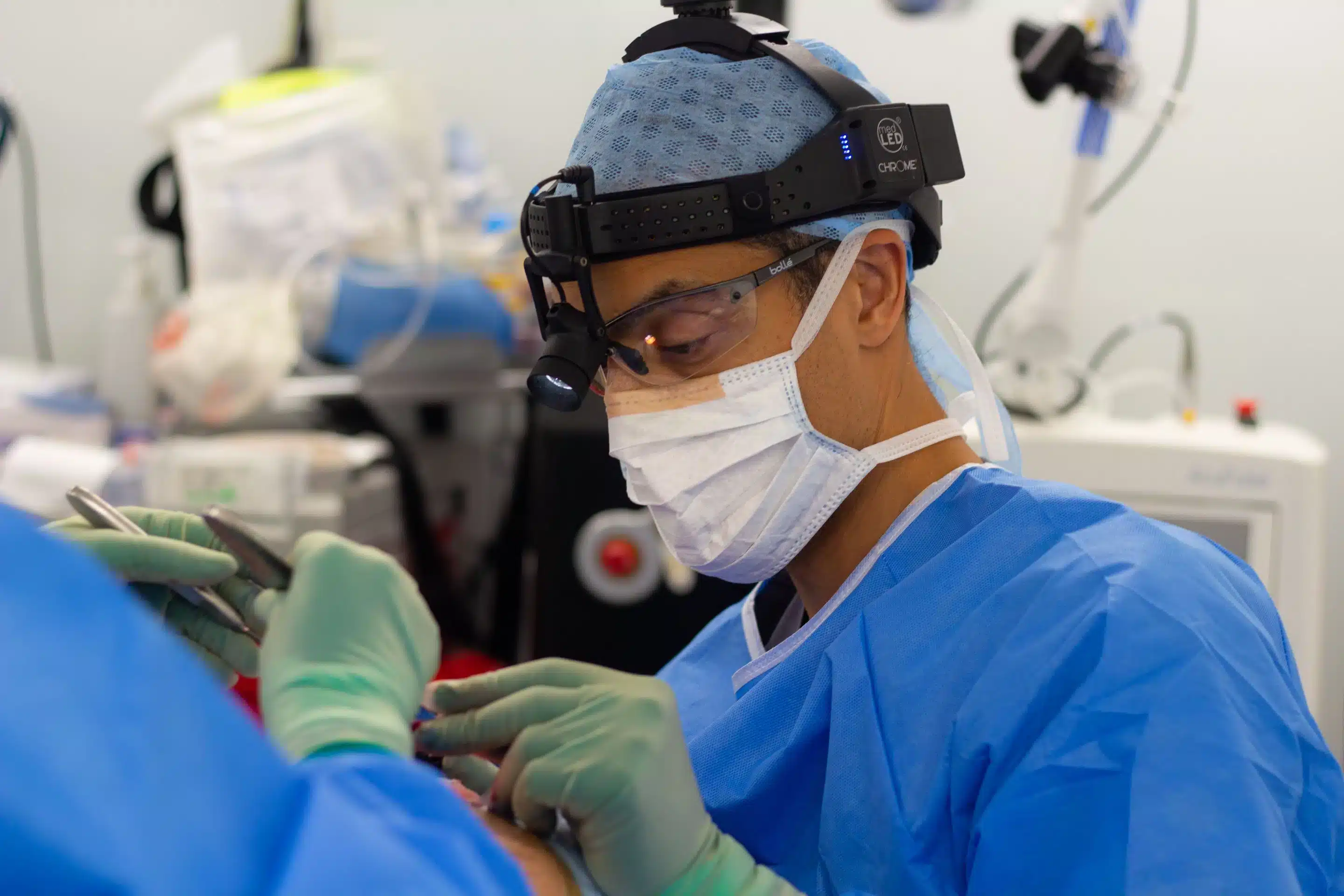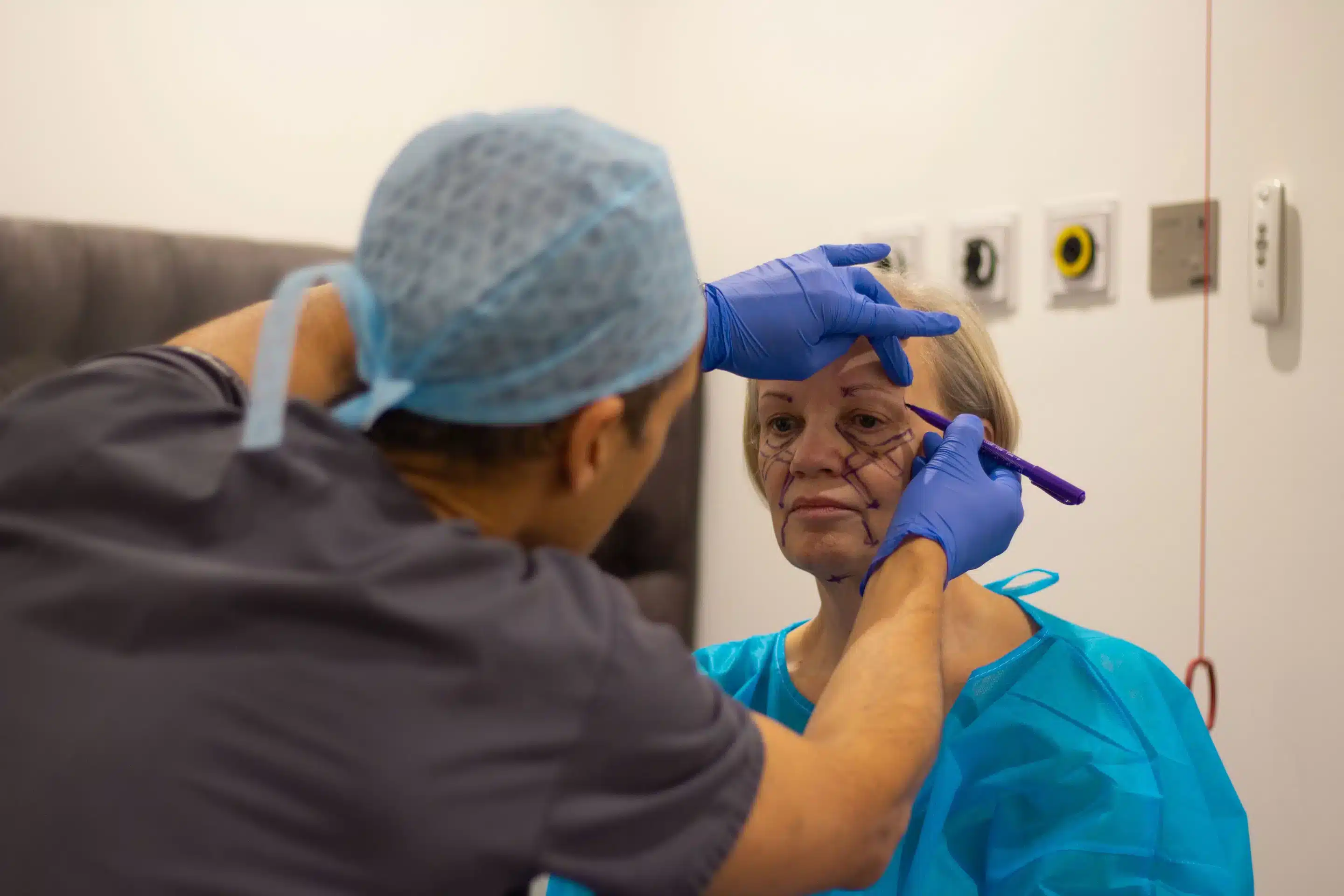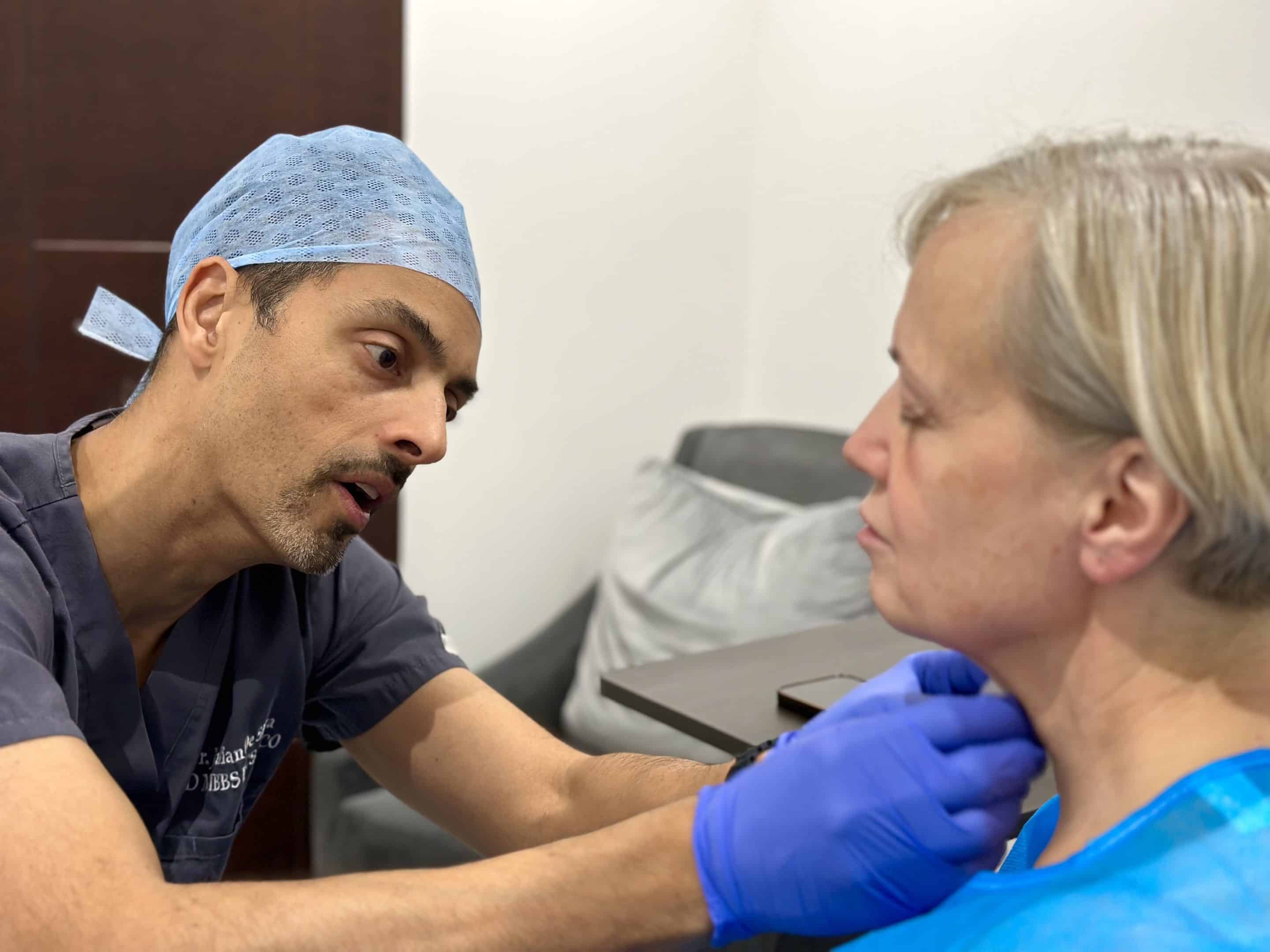
Whether it’s due to the wheel of time, inherited traits, or medical issues, hooded eyes can make you look older and tired, even when you’re actually younger and well-rested.
If you’re frustrated by your hooded eyes, many cosmetic treatments can make them go away. In this article, I’ll discuss hooded eyes and the different treatments you can get for a more youthful look.
How Can I Tell if My Eyes Are Hooded?

Here are some signs that you might have hooded eyes:
-
A Hooded Appearance
If the skin droops over your eyelid, creating a hood-like appearance, you likely have hooded eyes.
-
Eyes That Seem Small
The excess layer of skin can obscure a part of the eyelid, making your eyes seem more petite than they truly are.
-
Constrained Eyelid Area
People with hooded eyes may find that there’s a reduced canvas on their eyelid for makeup or skincare application.
-
Challenges with Cosmetics
Putting on eye makeup might feel like a task and keeping it intact might be another challenge due to the unique structure of hooded eyes.
-
Appearance of Fatigue
The structure of hooded eyes might convey an impression of exhaustion or make one look more mature, even if you’re feeling lively.
Reasons Behind Hooded Eyes

Hooded eyes manifest due to a mix of natural factors and the passage of time.
-
Inherited Traits
Many have hooded eyes from birth, a result of their genetic code. It boils down to how their eyelid tissues, muscles, and even brow bones are structured. It’s just one of the myriad ways human eyes can be shaped, often a trait passed down through generations.
-
Ageing
As the years go by, our skin tends to lose its bounce and firmness thanks to a decrease in collagen and elasticity. Consequently, the skin around the upper eyelids might slacken, leading to a hooded look.
-
Excess skin or fatty tissue on the upper eyelid
Some people may have extra skin or fatty tissue on their upper lids, which can cause a hooded appearance. This can be caused by many factors, including genetics, ageing, or even weight gain.
-
Medical conditions
Certain medical conditions, such as thyroid disorders or ptosis (drooping of the upper eyelid), can cause hooded eyes. Hyperthyroidism, a condition where the thyroid gland produces too much thyroid hormone, can cause eyelid retraction and hooded eyes. Ptosis, drooping of the upper eyelid, can be caused by many factors, such as nerve damage, a congenital defect, or ageing.
What Nationality Has Hooded Eyes?

Hooded eyes can be seen in people of all ethnicities and races. The appearance of hooded eyes is caused by a combination of genetic, physiological, and environmental factors rather than ethnicity.
Some people are born with hooded eyes, while others may develop them as they age or due to medical conditions or medications. Ultimately, hooded eyes are not tied to any particular ethnicity or race.
What’s Your Eye Shape?

Here are some steps to help determine your natural eye shape:
-
Look in the mirror.
Stand in front of a mirror and examine the shape and structure of your eyes. Look for any distinctive features or patterns.
-
Take note of the eyelid crease.
The eyelid crease is a natural fold in the skin that runs across the top of the eyelid. Its presence and location can help determine the shape of your eye.
-
Measure the width (inner to outer corner) and length (eyelid to bottom).
Use a measuring tape or ruler to measure the width of your eye from the inner corners to the outer corners of the eyes. Then, measure the length from the top of the eyelid to the bottom of the lash line.
-
Compare your eyes with others.
Compare your eye shape to other eye shapes, such as almond eyes, round eyes, upturned eyes, close-set eyes, and downturned eyes. You can find photos of these eye shapes online. You can take a picture of your eyes and print photos online to compare them side-by-side.
-
Ask a professional.
If you’re still not sure of what your eye shape really is, you can ask an eye doctor or plastic surgeon.
Remember, your eyes are unique and the shape of your eyes can also change over time due to factors such as ageing or medical conditions.
How Can I Reduce My Hooded Eyelids?

Here are some ways to decrease the appearance of hooded eyelids:
-
Makeup
Harnessing the power of makeup can accentuate and modify the look of your eyes. Drawing attention to the outer corners with eyeliner or applying a pale shade of eyeshadow on the brow arch can simulate a more open and uplifted gaze.
-
Non-Surgical Alternatives
Options like anti-wrinkle treatment, dermal fillers, and laser treatments can provide a tightened look to the skin around your eyes, potentially decreasing the hooded effect of the lids.
-
Surgical Intervention
Blepharoplasty, also called eyelid rejuvenation surgery, involves extracting surplus skin and fat from either the upper or lower eyelids. This surgery can, in many instances, alleviate the hooded appearance by eliminating the overlying redundant skin.
Throughout this surgical journey, the practitioner focuses on sculpting and refining the eyelid, ensuring enhanced muscular tone and a clearer eyelid contour. The ultimate goal is to achieve a revitalized gaze, wherein the eyes appear more alert, and the lash line stands out more prominently. Nonetheless, outcomes can differ, so it’s wise to engage in a detailed discussion with an adept cosmetic surgeon to chart out the most suitable plan tailored for you.
Before & After Gallery: Hooded Eyes4
Take a look at the before and after photos of my patients:

A 27-year-old female patient expressed concern about the bags under her eyes and her tired appearance. In her quest to meet her objectives, she chose a discreet eyelid treatment known as transconjunctival blepharoplasty. This technique encompassed fat extraction, fortifying tendons through a procedure called canthopexy, and revitalising the skin affected by sun exposure using CO2 laser resurfacing. In addition, she underwent an upper blepharoplasty to address the fullness in her upper eyelid and loss of the eyelid crease. The procedure gave her a youthful appearance and enhanced the natural beauty of her green eyes and eyelid shape.

A 50-year-old female patient complained of heavy upper lids that caused her to look tired. She also had little to no eyelid visibility. I performed a conservative upper blepharoplasty, providing the patient with an elevated upper eyelid platform while preserving a natural appearance. Additionally, the skin on the lower eyelid was refreshed through skin resurfacing. The patient was very satisfied with the outcome, resulting in a naturally rejuvenated appearance.

A 51-year-old Asian woman was noted for having significant heaviness in her upper lids, along with sun damage on her face. I performed an upper blepharoplasty, hiding the incision within the patient’s natural skin crease while conservatively removing skin, muscle, and fat. In the after photo, she has a more youthful, natural appearance with more visible upper lids.
What Is the Best Treatment for Hooded Eyes?

Surgery is considered the most effective treatment for hooded eyes, particularly when the cause is due to excess fat or skin. Blepharoplasty, also known as eyelid surgery, can be performed to remove the excess skin and fat, tighten the muscles, and reshape the eyelid. This can help create a more open and youthful appearance for the eyes.
Cosmetic Surgery to Correct Hooded Eyes

Blepharoplasty or eyelid surgery is done for ideal candidates with hooded eyes. This procedure involves removing excess fat and skin from the upper lids and, in some cases, the lower eyelids. The procedure can also tighten the underlying muscles and reshape the eyelid to create a more open and youthful appearance for the eyes.
In addition, blepharoplasty can correct drooping eyelids. Droopy eyelids can cause cosmetic and functional problems (e.g., blurry vision), so getting surgery can help make people’s lives easier.
Blepharoplasty can be performed under sedation or general anaesthesia, depending on the extent of the procedure. The surgery usually takes several hours and can be performed on an outpatient basis.
Patient Story

As a 46-year-old woman, this patient was tired of being asked if she was always tired. The overhanging skin below her brows weighed her eyes down, making her look older and more exhausted than she felt.
As a result, the patient wanted to rejuvenate her tired eyes. She reached out to the London Centre for Advanced Facial Cosmetic Surgery, headed by me, Dr. Julian De Silva.
During our consultation, we discussed her concerns. I suggested that upper and lower eyelid surgery was the best option for her. After the consultation, the patient decided to proceed with the procedure.
The upper eyelid surgery removed the excess skin, fat, and muscle that made her eyes look tired and older. On the other hand, the lower eyelid surgery repositioned some fat to areas of hollowing in her eyelid. This smoothened the puffiness, making her eyes appear more youthful. She also underwent eyelid support and TCA skin resurfacing to enhance the results.
The results of her eyelid surgery were amazing. As you can see in the picture, her eyes look much more alert. In addition, the excess skin is no longer hiding her eyes. The lower eyelid lines have been smoothened as well. The patient is extremely happy with the results, especially how well-rested her eyes look after the procedure.
Upper Blepharoplasty Video: How Is Upper Eyelid Surgery Done?
This upper blepharoplasty video shows how an upper eyelid is performed.
At my clinic, I prefer sedation anaesthesia because it helps my patients relax more. Also known as twilight anaesthesia, this one is safer than general anaesthesia.
To perform the eyelid surgery, I first mark the skin. This has to be extremely precise, as each patient’s eye is unique, and the incisions must be hidden under the natural crease of the eyelids.
Then, I remove the skin. Depending on the case, I also tighten the underlying obicularis muscle. After this, the fat is reshaped based on the patient’s eye shape and goal.
Next, the incisions will be closed through sutures and/or bioglue. Complementary procedures such as laser skin resurfacing can enhance the results.
Tom Cruise’s Eyelid Surgery

Source: NZ Herald
Tom Cruise is one of the highest-paid actors in the world due in part to his good looks and talent. He is known for performing daring stunts and is regarded as one of the sexiest actors in the world.
His work includes popular movies like Mission Impossible, Jack Reacher, The Last Samurai, and Top Gun Maverick. Over the course of his career, fans have noticed a change in Tom Cruise’s appearance, transitioning from a more boyish look to a fuller face with weight fluctuations.
In recent years, there have been rumors that he has undergone cosmetic procedures, including anti-wrinkle treatment, fillers, and eyelid surgery.
Many experts have weighed in on Tom’s change in appearance to overusing fillers. As a result, he looked so puffy that fans were so shocked by the sudden change.
The latest is the excess upper eyelid skin and wrinkles around the eyes. Over the years, Tom has benefited from a younger-than-his-age appearance, which can be attributed to various cosmetic procedures.
As seen in his photos, Tom has likely benefited from eyelid surgery, also known as blepharoplasty. It is a procedure that removes excess skin, fat, and muscle from the upper and/or lower eyelids to improve the appearance of sagging or drooping eyelids. Regardless, we can’t help but say that Tom Cruise is one of the most handsome men around.
Why Eye Surgery is the Best Treatment for Under Eye Wrinkles and Crow’s Feet

From giving permanent results to being effective, eyelid surgery is the best treatment for wrinkle on eyeball.
Here are the reasons why eyelid surgery is the best treatment for under eye wrinkles and crow’s feet:
1. Blepharoplasty effectively gets rid of under eye wrinkles and crow’s feet.
Due to its surgical nature, blepharoplasty or eyelid surgery effectively eliminates under eye wrinkles and crow’s feet.
Unlike non-surgical options, blepharoplasty can get rid of the most severe cases of under eye wrinkles and crow’s feet.
2. Eye cosmetic surgery produces permanent results.
Eye lifting surgery is the only permanent way to get rid of under eye wrinkles and crow’s feet. The effects of blepharoplasty can last for up to a lifetime.
In fact, many of my patients only had to get blepharoplasty once.
3. Blepharoplasty under eye is cost-effective in the long run.
Blepharoplasty requires a large investment. However, you only have to pay for the eye lift cost once, as opposed to non-surgical options.
Since the cost of non-surgical treatments accumulates over time, blepharoplasty is more cost-effective in the long run.
4. Blepharoplasty is safe.
While eyelid surgery comes with risks, the procedure is safe. I spent many years honing my skills in cosmetic surgery, so you are in safe hands.
Before Hooded Eye Surgery

Knowing how to get rid of hooded eyes includes understanding what happens before the treatment.
Before getting hooded eye surgery, you need to talk to a cosmetic surgeon who specialises in eyelid surgery. You can book a consultation with me here.
At the start of the consultation, we will discuss your medical history and current state.
Specifically, I will ask you about surgeries you had, if applicable. I will also ask about your current condition, including medication that you take, if applicable.
Next, we will discuss your lifestyle. I will ask you to disclose your alcohol and cigarette usage.
After this, we will talk about your goals. Each patient’s goal varies, so please openly discuss what yours are.
Depending on what we discussed, I will explain whether blepharoplasty surgery is the best treatment for you or not. I might also suggest complementary procedures such as facelift and brow & forehead lift.
If you agree with everything I discussed, you can then set an appointment for the surgery. Make sure that you set an appointment that best suits your schedule.
Eyelid Surgery: Best Treatment for Hooded Eyes

Knowing how to get rid of hooded eyes includes understanding the best treatment for them.
Thanks to advances in the cosmetic industry, you have many options for treating your hooded eyes. In extremely mild to mild cases, non-surgical eyelift can treat your hooded eyes.
While non-surgical eyelift sounds promising, it cannot treat all cases of hooded eyes. Only eyelift surgery can. Due to this, eyelid surgery is the best treatment for hooded eyes.
For one, eyelid surgery or blepharoplasty can treat all cases of hooded eyes. From mild to severe cases, a cosmetic surgeon can manipulate your skin and underlying muscles to get rid of your hooded eyes for good.
Blepharoplasty also produces permanent results. Unlike non-surgical procedures, the results of blepharoplasty last for decades to a lifetime.
Lastly, blepharoplasty produces subtle, natural results. Your eyes will change, but people around you won’t notice it unless you tell them. However, these results can only be delivered by a highly qualified cosmetic doctor. Thus, you have to be extremely careful when choosing a doctor to work with.
Visit Dr. Julian de Silva – Blepharoplasty, London
Do you want to make your eyes open and look more refreshed? Book a consultation with me, Dr. Julian De Silva, to know the best treatment options for your jowls. Alternatively, you may visit us at 23 Harley St, London W1G 9QN, UK.





